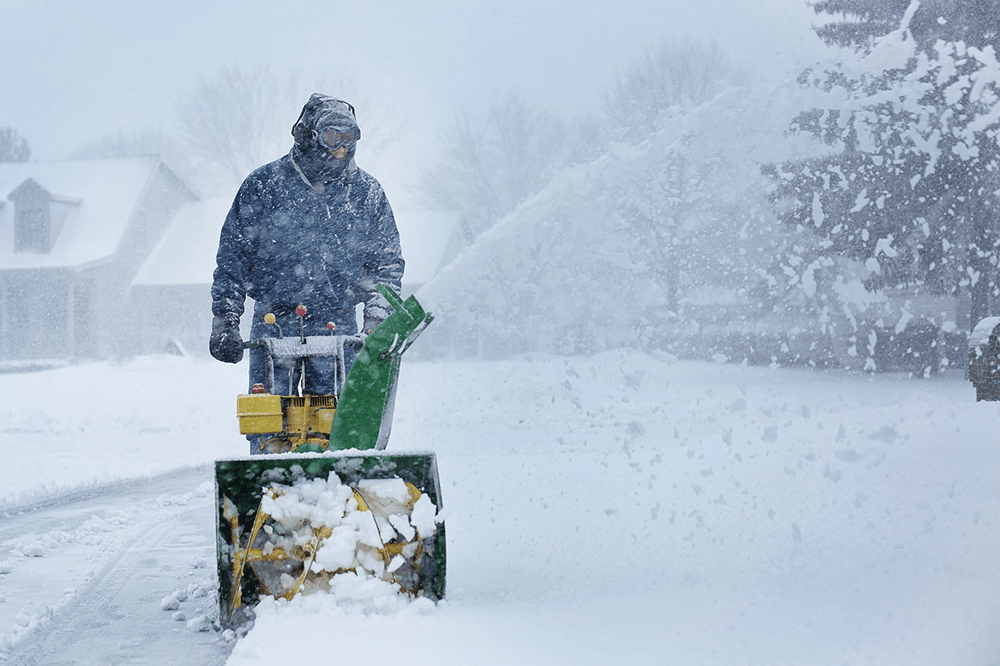
 Packing Tips
Packing TipsPreparing Your Snowblower for Long Term Storage
Your snowblower has worked hard all winter and is ready to be put in storage while the weather's nice and warm. It has taken on difficult jobs in clearing roadways and has accumulated dirt and grime while the engine worked hard.
In addition to maintaining this equipment during the months of heavy use, your snowblower needs special care before placing it in long-term storage. This prevents rust and build-up that could shorten its life or stop it from working altogether. Here's everything you need to do before placing your snowblower in storage.
Step 1: Empty the gas tank
To prevent gum deposits and rust from forming inside the hose, filter, gas tank, and carburetor during storage, your snowblower needs to be emptied of its fuel. Leaving fuel in the gas tank can damage a snowblower. It's better to drain the tank completely and treat it to prevent moisture buildup.
A carburetor or fuel line that has buildup from old gasoline can be extremely difficult to clean and can cause expensive and time-consuming repairs. You may also not be able to use the snowblower when you need it and be stuck shoveling snow yourself during a blizzard!
Before draining the fuel for the last use, insert a fuel stabilizer and run the machine to have the solution course through the system. A fuel stabilizer prevents moisture from forming in the snowblower's internal parts.
When left untreated, moisture gums up and creates buildup like rust and clogs. After using the fuel stabilizer has run through the system, siphon out the rest of the fuel and then run the snowblower again until there is absolutely no gas left.
Extra tip: Every time you fill the gas tank of your snowblower, add fuel stabilizer into the gas can so that no moisture builds up when it isn't used during the winter as well.
Step 2: Remove the spark plug
Before you go on to the next steps, it's important to make sure the snowblower doesn't accidentally turn on during the "winterizing" process. By removing the spark plug, you eliminate the possibility of the machine turning on as you clean the snowblower and perform other maintenance tasks. After you remove the spark plug, lubricate the cylinder wall and piston to prevent rust and remove some grime.
You may also choose to reinsert the spark plug after you finish all the preparation steps. Pull the spark plug until you can feel resistance, which is a sign that the piston has sealed the chamber. This step ensures that no moisture gets into the chamber from the outside air, which is especially important during the summer when humidity is high. To be even more ready for the next season, replace the old spark plug with a new one.
Step 3: Wipe away salt stains
Since snowblowers operate in the winter when salt trucks and homeowners use plenty of salt to keep surfaces safe, corrosion can easily happen to a snowblower from this substance. This is often an overlooked step, but if left alone, salt can corrode your snowblower during storage. Use a warm, wet cloth to wipe down the machine and let it fully dry.
Then, spray any exposed metal with an engine storage spray that provides extra protection against corrosion. This is also a good maintenance step to practice during the winter after each time you use the snowblower.
Step 4: Drain or change the oil
Be sure to check your machine's operation manual to find out what type of engine your snowblower has and the best practices for oil management in the off-season. If your snowblower doesn't have a 4-cycle engine, then you need to drain the oil before storage.
Be sure to carefully remove the oil and dispose of it in a fully sealed container. If you have any other type of snowblower engine, then you can change the oil before storage. This leaves you with a fresh start for the next season.
Step 5: Inspect all of the snowblower's parts
Snowblowers have a lot of important parts that are prone to wear and tear due to their exposure to salt, moisture, and extreme cold. Before you store your snowblower, inspect parts such as the snow thrower belts to see if they are in good condition or merit a replacement before storage. It is also a good idea to keep spare parts on hand so that you're not snowed in your house because of a faulty snowblower!
Extra tip: Keep a screwdriver and wrench on hand to stay on top of other key maintenance. If you find loose bolts during your inspection, tighten these parts which can easily shake loose during rigorous use.
Step 6: Keep the snowblower covered
After you complete the preparation procedure, it'd be a shame to miss the final and important step in preserving your snowblower: keep it covered. If you leave this machine exposed, it will collect dust in the engine. It will also be exposed to pests, moisture, and general wear and tear.
You may use an old blanket or plastic sheet if you're in a pinch, but a specialized snowblower cover isn't costly and can do a better job. A snowblower cover will protect the snowblower's exterior from scratches and maintain the luster of its paint. These covers are designed to breathe, which stops moisture from accumulating during humid summers.
Extra tip: Place your machine on a snowblower garage mat to keep it fully protected from top to bottom.
Can You Store A Snowblower Outside?
Storing a snowblower outside is generally not recommended if you want to ensure its longevity and reliable performance. Exposure to the elements, including rain, snow, and fluctuating temperatures, can lead to rust, corrosion, and damage to the snowblower's components. Moisture can also cause fuel system issues and potentially harm the engine. To protect your snowblower, it's advisable to store it in a dry and sheltered space, such as a garage or shed, and properly prepare it for storage by draining fuel and performing routine maintenance. This will help extend the life of your snowblower and ensure it's ready to tackle winter's challenges when needed.
We're Your Storage Solution!
Storage Rentals of America is your convenient self-storage solution. So come into our office or give our storage experts a call at 1-800-457-5678. Our call center is available 7 days a week and can help determine which storage unit size best fits your storage needs.



